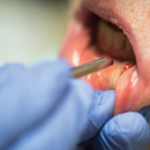NEW YORK (Reuters Health)—Ultrasonography of the major salivary glands may have a role in the diagnostic evaluation of patients with clinically suspected primary Sjogren’s syndrome, researchers from the Netherlands report.
Salivary gland biopsies and anti-SSA/Ro antibodies are important for classifying patients as primary Sjogren’s syndrome (pSS). Some studies have also supported using ultrasonography of the major salivary glands as a diagnostic method.
Dr. Hendrika Bootsma from University Medical Center in Groningen and colleagues in the EULAR US-pSS Study Group assessed the validity of salivary gland ultrasonography compared with parotid and labial gland biopsies, sialometry, and anti-SSA/Ro antibody status and various classification criteria in their cross-sectional study of 103 patients with clinically suspected pSS.
Salivary gland ultrasonography predicted parotid gland biopsy outcomes with 84.9% accuracy and an optimal cutoff ultrasound score of 15 (of a possible 48 points) and labial gland biopsy outcomes with 82.4% accuracy and an optimal cutoff score of 14, the team reports in Annals of the Rheumatic Diseases, online July 28.
Salivary gland ultrasonography also predicted anti-SSA/Ro antibody status well, with 80.3% accuracy. In contrast, it was a poor predictor of sialometry outcomes, with only 69.6% accuracy.
Ultrasonography proved to be accurate at predicting pSS classifications according to American European Consensus Group (AECG), American College of Rheumatology (ACR), and ACR-European League Against Rheumatism (EULAR) classification criteria.
Among patients with positive salivary gland ultrasonography findings combined with anti-SSA/Ro antibodies, 78% had a positive parotid gland biopsy and 94% had a positive labial gland biopsy; 94% or more of these patients met classification criteria for pSS.
Similarly, most patients with negative ultrasonography findings and absence of anti-SSA/Ro antibodies had negative parotid gland biopsies (93%) and negative labial gland biopsies (77%) – and did not fulfill pSS criteria.
The authors offer two conclusions. First, they write, “Positive salivary gland ultrasonography (sUS) predicts classification according to the AECG, ACR, and ACR-EULAR classification criteria, but negative sUS does not exclude classification.”
Second, “Positive sUS in combination with presence of anti-SSA/Ro antibodies highly predicts classification according to the AECG, ACR and ACR-EULAR criteria. The combination of negative sUS and absence of anti-SSA/Ro antibodies highly excludes classification when parotid gland biopsy outcome is considered as an item for classification, but when the outcome of labial gland biopsy is considered as a criteria item, combining negative sUS with absence of anti-SSA/Ro antibodies does not exclude classification.”
Dr. Bootsma did not respond to a request for comment.
Reference
- Mossel E, Delli K, van Nimwegen JF, et al. Ultrasonography of major salivary glands compared with parotid and labial gland biopsy and classification criteria in patients with clinically suspected primary Sjögren’s syndrome. Annals of the Rheumatic Diseases. 2017 Jul 28. [Epub ahead of print]

